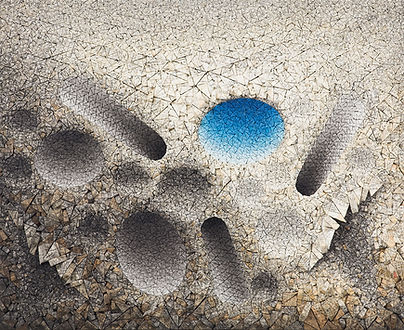CHUN KWANG YOUNG
b.1944, Korea
전광영은 반 세기에 가까운 활동기간 동안 한국의 중요한 시각 예술가로서 명성을 쌓아 왔다. 그의 작품은 20세기말과 21세기의 첫 해에 걸친 한국 현대미술, 한국과 서구 아방가르드 사이의 관계 모두에서 몇 가지 중요한 사안들을 상징하고 있다. 1960년대 말부터 1990년대 중반까지 전광영은 주로 연작을 제작하면서 색감과 선, 깊이와 질감의 회화적이고 표현적인 발전을 이루었다. 이는 우선 미국 추상표현주의의 형식과 기법의 혁신에 반응하는 것이었으며, 색면과 후기회화적 추상에 대한 더욱 “차가운” 접근이었다. 이러한 미국의 미술운동으로부터 영향을 받으면서, 특히 필라델피아에서 체류하는 동안(1969-77), 그의 회화 작품들은 형식적 실험에 대한 헌신과 자아에 입각한 표현 양식을 넘어 작품의 전체적이고 요소적인 효과, 찰나, 초월, 그리고 암시 - 자아, 자연, 사회에 대한 암시 - 들로부터 기인하는 더욱 커다란 경험의 범위를 탐구하는 것으로 발전하였다. 1990년대까지 그는 메타포이자 갈등의 양식으로서 회화를 재고찰하였다. 1995년부터 전광영은 집합이라는 제목의 커다란 작품들을 제작해왔다. 집합에서 비롯되는 힘과 독창성에 대해 충분히 이해함으로써, 우리는 필라델피아 미술대학원의 젊은 한국인 학생으로 시작하였던 전광영의 예술 인생에서부터, 조국 뿐 아닌 세계 미술무대에서의 그의 현재 위상까지를 짚어볼 수 있을 것이다. 서울 국립현대미술관은 그를 2001년 올해의 작가로 선정하였다. 그 해는 독일 쿤스트베르크 미술관(Kunstwerk Museum)에서 안젤름 키퍼(Anselm Kiefer)와 고트하르트 그라우프너(Gotthard Graubner)와 함께 전시를 열었던 해였다. 명망 높은 작가들과 함께 전시를 열었던 작가의 입지는 전시의 성공과 함께 오히려 전광영 작가를 고립시키려는 위협으로 다가왔다. 추상표현주의 미술가인 윌렘 드 쿠닝(Willem de Kooning)은 이렇게 말했다. “작품 그 자체로만 보여지는 일은 없다. 작품은 그 자체로서만 표현되는 것이 아닌, 역사성과 많은 담론들을 필요로 하는 존재이며, 한 작가 전체 인생의 부분인 것이다”[1] 집합의 역사와 배경에 있어서는 많은 이야기들이 필요할 것이다. 그러나 우리는 우선 집합 작품의 물리적 존재감으로부터 나오는 힘을 먼저 되짚어 보아야 할 것이다.
Having emerged during a career spanning nearly half a century as one of Korea's foremost visual artists, the work of KwangYoung Chun has come to emblematize some of the key issues that have unfolded in both Korean contemporary art and the relations staged between the Korean and Western avant-gardes during the last decades of the twentieth and the first years of the twenty first centuries. From the later 1960s until the mid-1990s Chun undertook a scrupulous, often serial, investigation into the pictorial and expressive qualities of color, line, depth, and texture, responding first to the furious formal and technical innovations of American Abstract Expressionism and then to the "cooler" approach of Color Field and post-painterly Abstraction.Since 1995, KwangYoung Chun has been making large works called Aggregations. A full appreciation of their power-and originality-will take us from the beginning of Chun's career, as a young Korean MFA candidate at the Philadelphia College of Art, to his present eminence not only in his homeland bus also in the international art world. The National Museum of Contemporary Art, in Seoul, named him Artist of the Year in 2001. In 2012 he showed his work in the company of Anselm Kiefer and Gotthard Graubner at the Kunstwerk Museum, in Eberdingen-Nussdorf, Germany. As well-deserved as they are, these signs of recognition threaten to isolate Chun's work in the glow of its success. The Abstract Expressionist Willem de Kooning once said, "There's no way of looking at a work of art by itself. It's not self-evident-ith needs a history, it needs a lot of talking about; it's part of a man's whole life." There is much to say about the history and context of the Aggregations. First, though, we should note the strength of their physical presence.
Notes:
1. TERRAFORM: THE ART OF KWANG YOUNG CHUN by John C. Welchman, Art Critic
2. "Aggregations: Kwang Young Chun and the Human Condition" by Carter Ratcliff, Art Critic
WORKS
.jpg)
.jpg)
.jpg)
Aggregation 22-JU162
2022
Aggregation 21-SE124
2021
Aggregation 12-JA002 BLUE
2012
CV
EDUCATION
M.F.A., Philadelphia College of Art
B.F.A., Hong-Ik University, Korea
SELECTED SOLO EXHIBITIONS
2024 MEMORIES, MESSAGES AND MEANINGS, New York, USA
2023 The Dimension of Threshold : Tang contemporary art Beijing Solo exhibition, Beijing, China
2022 BIENNALE ARTE
2022 Chun Kwang Young : Times reimagined, Venice, Italy
2022 Moscow Museum of Modern Art, Moscow, Russia
2021 Museum Ground, Yongin, Korea 2020 Musuem Ground, Yongin, Korea
2019 Jordan Schnitzer Museum of Art, Oregon, USA
2019 Sundaram Tagore Gallery, Singapore, Singapore
2019 Beck & Eggeling Gallery, Dusseldorf, Germany
2018 Brooklyn Museum, New York, USA
2018 Sundaram Tagore Gallery, New York, USA
2018 PKM Gallery, Seoul, Korea 2017 Museum De Reede, Antwerp, Belgium
2017 Beck & Eggeling Gallery, Vienna, Austria
2017 Pearl Lam Galleries, HongKong, China
2017 Villa Empain - Boghossian Foundation, Brussels, Belgium
2016 Wooyang museum of contemporary art (Artsonje museum), Gyeongju, Korea
and more
SELECTED GROUP EXHIBITIONS
2021 Luna Sonata: Hanji Works and Contemporary Art, Jeonbuk Museum of Art, Jeonju, Korea
2020 Dep Art Gallery, Milan, Italy 2020 Lee Ungno Museum, Daejeon, Korea
2020 Moment of ㄱ (Giyeok : name of the first letter of the Korean alphabet), Hangaram Art Museum, Seoul, Korea
2018 Beck & Eggeling Gallery, Düsseldorf, Germany
2016 Hong Kong Group Show, Pearl Lam Galleries, Hong Kong
2015 Venice Biennale, Palazzo Grimani Art Museum, Venice, Italy
2015 Museum SAN, Wonju, Korea
and more
AWARDS
2009 Presidential Prize in the 41st Korean Culture and Art Prize, The Ministry of Culture, Sports and Tourism, Korea
2001 Chun Kwang Young; Artist of the Year 2001, National Museum of Contemporary Art, Korea
1974 Silver Prize in the 27th Cheltenham Art Center Exhibition sponsored by Cheltenham Art Center, USA
and more
PUBLIC AND PRIVATE COLLECTIONS
Seoul Museum of Art (Korea), The Leeum (Korea), Wooyang Museum of Contemporary Art (Korea), National Museum of Modern and Contemporary Art, Gwachun (Korea), Busan Metropolitan Art Museum (Korea), The Seoul National University Museum of Art (Korea), The British Musuem (UK), Victoria & Albert Museum (UK), University of Virginia Art Museum (USA), Yale University Art Gallery (USA), Columbia University of Law (USA), Rockfeller Foundation (USA), United Nations headquarters (USA), KUNST Museum BonnBonn (Germany), National Gallery of Australia at Canberra (Australia), How Art Museum (China) and more
